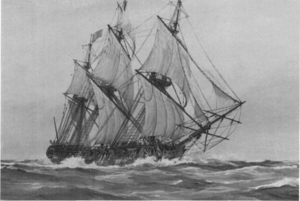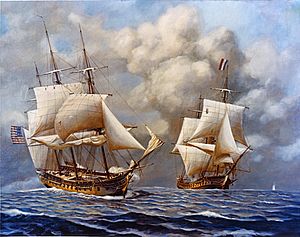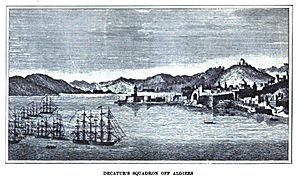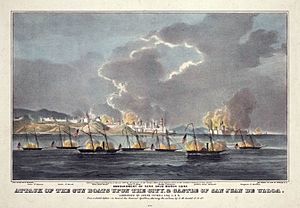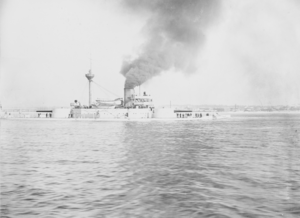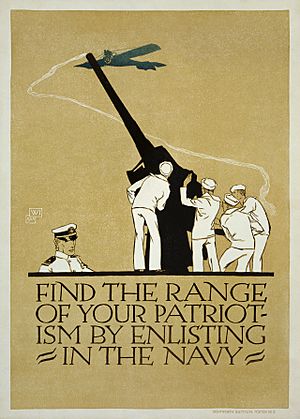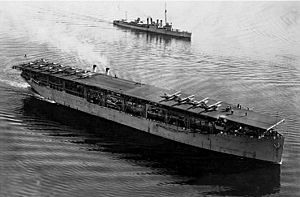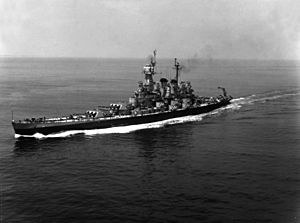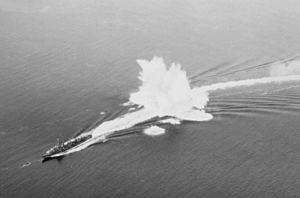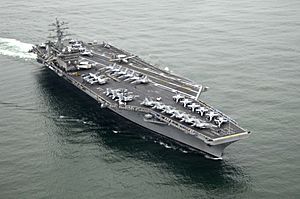History of the United States Navy facts for kids
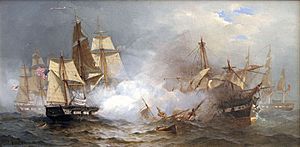
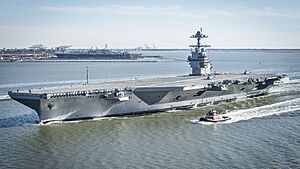
The history of the United States Navy can be split into two main parts. The "Old Navy" was a smaller force of sailing ships. It was known for using new ironclad ships during the American Civil War. The "New Navy" started in the 1880s with a big upgrade. By 1943, it had become the largest navy in the world.
The United States Navy officially began on October 13, 1775. On that day, the Second Continental Congress created the Continental Navy. After the American Revolutionary War ended, this navy was shut down. But under President John Adams, American merchant ships faced attacks from pirates in North Africa. This led to the Naval Act of 1794, which created a permanent US Navy. The first six frigates were built because of this law.
Over the next 20 years, the Navy fought against the French Republic Navy in the Quasi-War (1798–99). It also fought the Barbary states in the First Barbary War and Second Barbary War. Then came the War of 1812 against the British. After 1812, the US Navy was mostly at peace until the Mexican–American War in 1846. During this time, it fought pirates in the Mediterranean and Caribbean seas. It also worked to stop the slave trade off West Africa. In 1845, the United States Naval Academy was founded in Annapolis, Maryland.
In 1861, the American Civil War started. The US Navy fought the smaller Confederate States Navy. They used both sailing ships and new ironclad ships. The Navy also set up a blockade that stopped the Confederacy's coastal shipping. After the Civil War, most ships were put away. By 1878, the Navy had only about 6,000 sailors.
By 1882, many US Navy ships were old. Over the next ten years, Congress approved building modern steel armored cruisers and battleships. By the early 1900s, the US Navy had moved from twelfth place in 1870 to fifth place in ship numbers. After winning two major battles in the 1898 Spanish–American War, the Navy kept building more ships. By the end of World War I, it had more people in uniform than the British Royal Navy.
The Washington Naval Conference in 1921 agreed that the US Navy could have the same number of large warships as the Royal Navy. In the 1920s and 1930s, the Navy built several aircraft carriers and battleships. The Navy joined World War II after Japan attacked Attack on Pearl Harbor on December 7, 1941. Over the next four years, it fought many big battles. These included the Battle of the Coral Sea, the Battle of Midway, and the Battle of Leyte Gulf, which was the largest naval battle ever. Much of the Navy's work involved supporting landings, like the "island-hopping" campaign in the Pacific. When Japan surrendered, a large group of ships entered Tokyo Bay. The formal ceremony happened on the battleship Missouri. By the end of the war, the Navy had over 1,600 warships.
After World War II, the US Navy entered the 45-year-long Cold War. It took part in the Korean War, the Vietnam War, the First Persian Gulf War, and the Iraq War. When the Soviet Union fell apart in 1990–91, the US became the world's strongest naval power. New technologies like nuclear power and ballistic missiles led to new ships and weapons. These included the Nimitz-class aircraft carriers and Ohio-class submarines. By 1978, the number of ships had dropped to under 400. Many were from World War II. This led President Ronald Reagan to start a plan for a modern, 600-ship Navy.
Today, the United States is still the world's strongest naval power. It can fight two smaller wars at the same time in different places. In March 2007, the US Navy had its smallest fleet since World War I, with 274 ships. Some former Navy leaders have worried about the Navy's ability to respond to actions by Iran and China. In 2020, the Chinese People's Liberation Army Navy became larger than the US Navy in terms of the total number of ships.
The American Navy grew from a strong tradition of seafaring. During the Revolution, several states had their own small navies. Rhode Island created its navy on June 12, 1775.
Rhode Island was the first to suggest a Continental Navy. Its merchants had been bothered by British ships. On August 26, 1775, Rhode Island asked the Continental Congress to fund a single Continental fleet. This idea was discussed on October 3, 1775. Meanwhile, George Washington started buying ships himself, like the schooner USS Hannah. It was launched on September 5, 1775.
The US Navy officially began on October 13, 1775. On this day, Congress agreed to buy two ships to fight British merchant ships. On December 13, 1775, Congress approved building thirteen frigates.
On Lake Champlain, Benedict Arnold ordered 12 Navy ships built. This was to slow down the British fleet invading New York from Canada. The British did destroy Arnold's fleet. But the US ships slowed them down after a two-day fight called the Battle of Valcour Island. This helped delay the British Army. By mid-1776, many ships were being built. But they were no match for the powerful Royal Navy. Most were captured or sunk by 1781.
Private ships, called Privateers, had more success. Congress issued 1,697 "letters of marque" allowing them to attack enemy ships. More than 2,000 such permits were given out. American privateers captured over 2,200 British ships. This was worth about $66 million, a huge amount back then.
A famous American naval hero of the Revolution was John Paul Jones. In his journey around the British Isles, he defeated the British ship Serapis (1779) in the Battle of Flamborough Head. During the battle, with ships tangled and his own ship, Bonhomme Richard (1765), damaged, Jones was asked if he would surrender. He famously replied, "I have not yet begun to fight!"
France joined the war on June 17, 1778. French Navy ships mostly stayed in the West Indies. In 1779, a French fleet helped American forces try to recapture Savannah, Georgia. In 1780, a French fleet with 6,000 troops landed in Rhode Island. In 1781, Washington and the French planned an attack in the Chesapeake Bay area. On September 5, 1781, the French fleet won the Battle of the Virginia Capes. This gave them control of the Chesapeake Bay. The US Navy kept stopping British supply ships until peace was declared in late 1783.
The Revolutionary War ended with the Treaty of Paris (1783) in 1783. By 1785, the Continental Navy was disbanded. Its remaining ships were sold. The frigate Alliance, which fired the last shots of the war, was the last ship in the Navy. Some in Congress wanted to keep it, but the new country didn't have the money. The young United States also needed money from taxes on imported goods. To stop smuggling, the United States Congress created the United States Revenue Cutter Service on August 4, 1790. This was the only armed sea service until the Navy Department was created in 1797.
After the war, American merchant ships were no longer protected by the British Navy. They were open to pirate attacks. The US couldn't afford to pay yearly tributes to the Barbary states. So, its ships were easily captured after 1785. In 1793, the French Revolutionary Wars began. A truce ended Portugal's blockade of the Strait of Gibraltar, letting Barbary pirates into the Atlantic. They captured 11 American merchant ships and over a hundred sailors.
Because of these attacks, Congress debated and approved the Naval Act of 1794. This allowed the building of six frigates. Supporters said a Navy would save money on insurance and ransom. Opponents thought it was too expensive and would lead to more wars.
A New Start (1794–1812)

After the Naval Act of 1794 passed, work began on six frigates: USS United States, President, Constellation, Chesapeake, Congress, and Constitution. The Constitution, launched in 1797, is the most famous. It was nicknamed "Old Ironsides" and is still in Boston harbor today. Congress also approved money for a treaty with the Algerians. This meant that if peace was made, ship construction would stop. Three frigates were finished: United States, Constitution, and Constellation. However, the first naval ship to sail was USS Ganges, on May 24, 1798.
At the same time, problems between the US and France led to the Quasi-War. This war started because of an old alliance treaty from the Revolutionary War. The US wanted to stay neutral in conflicts between France and Britain. But this angered both countries. After the Jay Treaty with Britain in 1794, France began seizing American ships. By 1797, they had taken over 300 vessels. President John Adams worked with Congress to finish the frigates and try to make a deal with France. The XYZ Affair involved French agents asking for a bribe before talks could begin. This scandal made many Americans want war with France. The United States Department of the Navy was created on April 30, 1798, to manage the Navy better.
The war with France was mostly fought at sea. The first US Navy victory was on July 7, 1798, when USS Delaware captured a French privateer. The first victory over an enemy warship was on February 9, 1799. The frigate Constellation captured the French frigate L'Insurgente. Peace with France was declared by the end of 1800. In 1801, a law was passed to keep a peacetime navy. It limited the Navy to six active frigates.
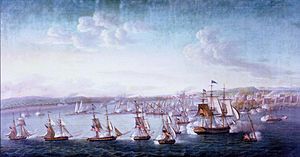
The problems with the Barbary states continued. On May 10, 1801, the Tripolitans declared war on the US. This started the First Barbary War. USS Philadelphia was captured by the Moors. But Stephen Decatur led an American raid to burn it. In 1805, the Marines invaded the "shores of Tripoli" and captured the city of Derna. This was the first time the US flag flew over a foreign conquest. This action convinced the Barbary rulers to sign peace treaties. After this, the Navy was made much smaller to save money. Many small gunboats were built for coastal use, but they were not very effective.
President Thomas Jefferson and his party did not want a strong navy. They thought small gunboats in harbors were enough. But these proved useless in wartime.
The British Royal Navy kept illegally forcing American sailors into their service. This was called "impressment." About 10,000 sailors were taken between 1799 and 1812. In 1807, in the Chesapeake-Leopard Affair, HMS Leopard attacked USS Chesapeake when it refused to be searched for British citizens. Leopard badly damaged Chesapeake. This event increased tensions, and in June 1812, the US declared war on Britain.
The War of 1812 (1812–1815)
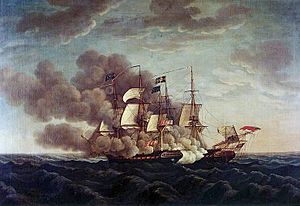
Much of the war was expected to be fought at sea. The small American navy, outnumbered 50-to-1, set out to fight. After two months, USS Constitution sank HMS Guerriere. Guerriere's crew were amazed that their cannonballs bounced off Constitution's strong live oak hull. This gave Constitution its nickname, "Old Ironsides." On December 29, 1812, Constitution defeated HMS Java off Brazil. On October 25, 1812, USS United States captured HMS Macedonian. Macedonian was then used by the American Navy. In 1813, USS Essex raided British merchant and whaling ships in the South Pacific. The British sent two ships, HMS Cherub and HMS Phoebe, to stop Essex. They captured Essex in the Battle of Valparaíso.
The capture of three British frigates led Britain to send more ships to blockade the American coast. On June 1, 1813, off Boston Harbor, USS Chesapeake was captured by HMS Shannon. Captain James Lawrence of Chesapeake was badly hurt and famously said, "Don't give up the ship!" By 1814, many of the Navy's best ships were stuck in port. They could not stop British attacks from the sea.
In the summer of 1814, the British attacked Washington and Baltimore. Washington fell easily, and several ships were burned. At Baltimore, the attack on Fort McHenry inspired Francis Scott Key to write "The Star-Spangled Banner". The British army left after failing to enter the harbor.
American naval victories at the Battle of Lake Champlain and Battle of Lake Erie stopped the British in the north. This helped the US keep rights to the Great Lakes in the Treaty of Ghent. Shortly before the treaty, USS President was captured. Three days after the treaty, Constitution captured two more British ships. The last naval action of the war was on June 30, 1815. USS Peacock captured a British ship. This was the last enemy ship captured by the US Navy until World War II.
Growth and Exploration (1815–1861)
After the war, the Navy received better funding. Many new ships were built. However, large ships were very expensive. Many stayed unfinished in shipyards. The Navy's main force remained large sailing frigates and smaller sloops. By the 1840s, the Navy started using steam power and shell guns. But it was slower than France and Britain to adopt these new technologies.
Sailors during this time often included foreign-born men. American-born sailors were usually those with few other job options. In 1835, only 90 men were recruited by the Navy from Boston harbor, compared to almost 3,000 merchant sailors. It was illegal for black men to serve, but this rule was often ignored due to a shortage of men.
Discipline was similar to the Royal Navy, but punishments were milder. Flogging was abolished in the Army in 1812, but the Navy kept it until 1850.
During the War of 1812, the Barbary states again captured American ships and sailors. After the Treaty of Ghent, the US wanted to end this piracy. On March 3, 1815, Congress approved sending naval power against Algiers. This started the Second Barbary War. Two strong groups of ships, led by Commodores Stephen Decatur, Jr. and William Bainbridge, were sent to the Mediterranean. Decatur's group captured the Algerian flagship Meshuda and another brig. By June, peace was made with Algiers. This included returning captured ships and men, no more tributes, and trading rights.
Piracy in the Caribbean was also a big problem. Between 1815 and 1822, about 3,000 ships were captured. In 1819, Congress allowed President James Madison to deal with this threat. Many pirates were privateers from new Latin American countries. Madison decided to use diplomacy backed by Navy ships. An agreement was made with Venezuela in 1819. But ships were still captured until a military campaign by the West India Squadron. This group, led by David Porter, used large frigates to protect merchant ships. Smaller boats searched coves and islands, capturing pirate vessels. During this campaign, USS Sea Gull became the first steam-powered ship to see combat. By 1826, frequent attacks ended, and the region was safe for trade.
Another international issue was the slave trade. The Africa Squadron was formed in 1820 to stop it. Stopping the slave trade was not popular, and the squadron was pulled back in 1823. It didn't return to Africa until the Webster–Ashburton Treaty with Britain in 1842. After the treaty, the US used fewer ships than required. The ships were also too large to operate close to shore. Between 1845 and 1850, the US Navy captured only 10 slave ships. The British captured 423 ships with 27,000 captives.
Congress created the United States Military Academy at West Point in 1802. But it took almost 50 years to approve a similar school for naval officers. During the long peace from 1815 to 1846, young officers had few chances for promotion. The poor training of officers became clear after the Somers Affair in 1842. This was an alleged mutiny on the training ship USS Somers. Secretary of the Navy George Bancroft created a new academy for officers in 1845. He turned old Fort Severn in Annapolis, Maryland into a new institution. Congress officially named it the United States Naval Academy in 1851.
The Navy helped move the Seminole Indians from Florida. After a massacre of army soldiers in 1835, Marines and sailors joined the forces fighting the Second Seminole War (1836–1842). A "mosquito fleet" of small boats was formed in the Everglades. It transported Army and Navy personnel to chase the Seminoles into the swamps.
The Navy played a role in the Mexican–American War (1845–1848). During the Battle of Veracruz, it transported 12,000 troops and their equipment in one day. This led to the capture of Veracruz and eventually Mexico City. The Navy's Pacific Squadron helped capture California.
In 1853, Commodore Matthew C. Perry led the Perry Expedition. A group of four ships sailed to Japan to start normal relations. Perry's two advanced steam-powered ships and calm diplomacy convinced Japan to end three centuries of isolation. Japan signed the Treaty of Kanagawa with the US in 1854. This treaty opened Japan to trade with the United States and Europe.
The American Civil War (1861–1865)
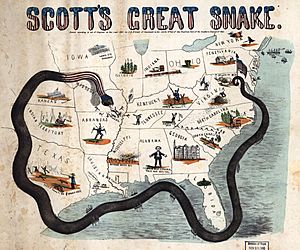
Between the start of the war and the end of 1861, 373 officers resigned from the US Navy. They went on to serve the Confederacy. On April 20, 1861, the Union burned its ships at the Norfolk Naval Shipyard to stop the Confederates from capturing them. But not all ships were fully destroyed. The screw frigate USS Merrimack was sunk so quickly that its hull and engine were mostly fine. This gave the South the idea to raise it and cover its sides with iron plates. This ship was named CSS Virginia. Meanwhile, John Ericsson had similar ideas and got money to build USS Monitor.
Winfield Scott, the US Army's commanding general, created the Anaconda Plan. His idea was that a Union blockade of major ports would weaken the Confederate economy. Then, capturing the Mississippi River would split the South. President Lincoln adopted the blockade part of the plan.
On March 8, 1862, the Confederate Navy started the first battle between ironclads. Virginia attacked the blockade. The next day, Monitor fought Virginia in the Battle of Hampton Roads. The battle was a draw. The Confederacy later lost Virginia when it was sunk to prevent capture. Monitor was the first of many "monitor" warships built by the Union Navy. The Confederacy built more ironclads, but they couldn't effectively fight the monitors.
New technologies like naval mines (called torpedoes then) and submarines were used by the Confederacy. During the Battle of Mobile Bay, mines sank the Union monitor USS Tecumseh. After Tecumseh sank, Admiral David G. Farragut famously said, "Damn the torpedoes, full speed ahead!" The CSS David, an early submarine, attacked USS New Ironsides with a "spar torpedo." The Union ship was barely damaged. Another submarine, CSS H.L. Hunley, was designed to dive and surface. It sank five times during tests. In action against USS Housatonic, it sank its target but was lost in the same explosion.
The Confederate States of America used "commerce raiders" and "blockade runners." CSS Alabama was the most famous raider. British investors built fast blockade runners that brought arms and luxuries to the South. They took cotton and tobacco back. When the Union Navy captured a blockade runner, the ship and cargo were sold. The money went to Navy sailors. Captured crewmen, mostly British, were usually released.
The blockade caused the Southern economy to collapse. Shortages of food and supplies happened because of the blockade, railroad failures, and armies taking food. The standard of living dropped, and printing too much paper money caused inflation. By 1864, food distribution broke down, leading to food riots. The Union victory at the Second Battle of Fort Fisher in January 1865 closed the last useful Southern port. This almost ended blockade running and sped up the war's end.
After the Civil War, the Navy declined. In 1864, it had 51,500 men and almost 700 ships, including about 60 monitor-type ironclads. This made the US Navy the second largest in the world. By 1880, the Navy had only 48 ships in service and 6,000 men. The ships and bases were in bad shape. Congress didn't see a need to spend money on them. The Navy was not ready for a major sea war before 1897.
In 1871, an expedition of five warships was sent to Korea. Led by Rear Admiral John Rodgers, it aimed to get an apology for murdered American sailors and a treaty to protect shipwrecked foreigners. After a small fight, Rodgers launched an attack of about 650 men on forts protecting Seoul. The Koreans refused to talk, and the expedition had to leave. Nine sailors and six Marines received Medals of Honor for their bravery.
By the 1870s, most Civil War ironclads were put away. The US had almost no ironclad fleet. When the Virginius Affair happened in 1873, a Spanish ironclad was in New York Harbor. The US Navy realized it had no ship that could defeat it. The Navy quickly ordered five new ironclads and sped up repairs on others. USS Puritan and four Amphitrite-class monitors were built. All five later fought in the Spanish–American War of 1898.
By 1881, the Navy's condition was even worse. A review found that out of 140 ships, only 52 could operate. Only 17 were iron-hulled, and 14 were old Civil War ironclads. The new Secretary of the Navy, William H. Hunt, saw the need to modernize. He set up a board to make recommendations. Morale was low. Officers knew their old wooden ships wouldn't last long in a war. The monitor ships also stopped the US from showing its power overseas. Until the 1890s, the US would have struggled in a fight with Spain or Latin American countries.
In 1882, Navy Secretary William H. Hunt asked Congress for money to build modern ships. The request was first denied. But in 1883, Congress approved building three protected cruisers: USS Chicago, USS Boston, and USS Atlanta. These were known as the ABCD ships. In 1885, two more protected cruisers were approved. Congress also approved building the Navy's first battleships: USS Texas and USS Maine. The ABCD ships were excellent. The three cruisers formed the "White Squadron," used to train officers and sailors. Before 1910, most enlisted sailors were foreigners who spoke little English.
Captain Alfred Thayer Mahan's book, The Influence of Sea Power upon History, 1660–1783, published in 1890, greatly influenced navies worldwide. In the US, it supported expansion to the government and public. With the American frontier closing, people looked outward to the Caribbean, Hawaii, and the Pacific. Many saw the Navy as key to expanding American influence.
In 1890, Mahan's ideas led Navy Secretary Benjamin F. Tracy to suggest building 200 ships. Congress rejected this. Instead, the Naval Act of 1890 approved building three battleships: USS Indiana, USS Massachusetts, and USS Oregon, followed by USS Iowa. By the early 1900s, more battleships were built or planned. This moved the US Navy from twelfth place in 1870 to fifth place among world navies.
The Spanish–American War (1898)
The United States wanted to buy colonies from Spain, especially Cuba, but Spain refused. Newspapers published stories, some made up, about bad things happening in Spanish colonies. This increased tension. A riot gave the US an excuse to send USS Maine to Cuba. The explosion of Maine in Havana Harbor increased public support for war with Spain. An investigation concluded the explosion was caused by a sea mine. Later investigations suggested an internal explosion from a fire in a coal bunker.
Assistant Navy Secretary Theodore Roosevelt quietly prepared the Navy for attack before the war was declared in April 1898. The Asiatic Squadron, led by George Dewey, left Hong Kong for the Philippines. It decisively defeated the Spanish fleet in the Battle of Manila Bay. A few weeks later, the North Atlantic Squadron destroyed most Spanish naval units in the Caribbean in the Battle of Santiago de Cuba.
The Navy's success in this war was encouraging. But it also showed that the enemy had a weak fleet. The Manila Bay attack was risky. American ships were 7,000 miles from the nearest US harbor. This experience greatly influenced Navy strategy and US foreign policy for decades.
Luckily for the New Navy, its biggest supporter, Theodore Roosevelt, became President in 1901. Under him, the Navy grew from the sixth largest to second only to the Royal Navy. Roosevelt's government got involved in Central American politics. In a 1901 speech, Roosevelt said, "Speak softly and carry a big stick, you will go far." This became a key part of his foreign policy.
Roosevelt believed a US-controlled canal across Central America was vital for the Navy. It would greatly shorten travel times between the two coasts. Roosevelt managed to get the US to buy the failed French effort to build a canal in Panama. Panama was controlled by Colombia. In early 1903, a treaty was signed to give the US control of the canal. When the Colombian Senate didn't approve it, Roosevelt hinted to Panamanian rebels that the US Navy would help them if they revolted. Panama declared independence on November 3, 1903. USS Nashville stopped any interference from Colombia. The Panamanians then gave the US control of the Panama Canal Zone for $10 million. The naval base at Guantanamo Bay, Cuba was built in 1905 to protect the canal.
Submarines, a new technology, were developed by John Philip Holland in New Jersey. His submarine, USS Holland, joined the US Navy in 1900. The Russo-Japanese War of 1905 and the launch of HMS Dreadnought in 1906 pushed the US to build more ships. In late 1907, Roosevelt had sixteen new battleships. He sent them on a world tour as the "Great White Fleet." This trip was peaceful and a good training exercise. But it also showed the world the United States' power. At every port, leaders were welcomed aboard. The trip worked, and American power was taken more seriously.
The voyage taught the Navy it needed more fueling stations worldwide. It also showed the importance of the Panama Canal, which was finished in 1914. The Great White Fleet needed almost 50 coal ships. Most of its coal was bought from the British.
World War I (1914–1918)
Mexico
When US agents found out a German ship was carrying illegal weapons to Mexico, President Wilson ordered the Navy to stop it. On April 21, 1914, a naval group of Marines and sailors occupied Veracruz. A total of 55 Medals of Honor were given for bravery there.
Preparing for War (1914–1917)
Despite US neutrality, the British passenger ship Lusitania was sunk by a German submarine in 1915. This led to calls for war. President Wilson made Germany stop unrestricted submarine warfare. After much debate, Congress passed the Naval Act of 1916. This approved a $500 million plan over three years to build 10 battleships, 6 battlecruisers, 10 scout cruisers, 50 destroyers, and 67 submarines. The idea was a balanced fleet. But destroyers became much more important for fighting submarines and protecting convoys. By the end of the war, 273 destroyers had been ordered. Most were finished after World War I, but many served in World War II.
Navy Secretary Josephus Daniels improved the Navy's education. He made the Naval War College important for future admirals. However, he angered officers with his strict reforms. He ignored the Navy's strategic needs and advice from experts. He cut in half the recommendations for new ships. Admiral William Sims later said that in April 1917, only ten percent of Navy warships were fully staffed. Most lacked 43% of their sailors. Only a third of the ships were fully ready. There were few light anti-submarine ships, even though U-boats had been a major foreign policy focus for two years.
Fighting a World War (1917–18)
President Wilson ordered the United States Marine Corps to increase its numbers on March 26. The United States Naval Academy class of 1917 graduated early on March 29, before America entered the war in April 1917. Retired officers were called back to duty to free younger officers for sea duty. The Navy took control of the Coast Guard and Naval Militia. It also took over all US wireless (radio) stations.
The Navy's role was mostly escorting convoys and transporting troops. It also helped lay the North Sea Mine Barrage. The first US military unit sent to Europe was a group of seven naval officers and 122 enlisted men. They arrived in France on June 5, 1917. The United States Navy sent a battleship group to Scapa Flow to join the British Grand Fleet. Destroyers went to Ireland, and submarines helped guard convoys. Several Marine regiments also went to France. The first Navy victory in the war was on November 17, 1917. USS Fanning and USS Nicholson sank the German U-boat U-58. During World War I, the Navy was the first US armed force to allow women to enlist in non-nursing roles, as Yeoman (F). The first woman to enlist was Loretta Perfectus Walsh on March 17, 1917.
The Navy's huge wartime growth was managed by civilian officials, like Assistant Secretary Franklin D. Roosevelt. The Navy yards expanded greatly. They hired other companies to make shells and explosives. Items like food and uniforms were bought from civilian companies. Armor plate and airplanes were also bought from the market.
Between Wars (1918–1941)
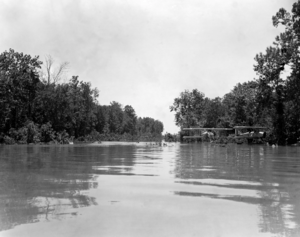
At the end of World War I, the US Navy had almost 500,000 people. It was the largest in the world in terms of personnel. Younger officers were excited about naval aviation and aircraft carriers. Chief of Naval Operations Benson tried to get rid of aviation in 1919. But Roosevelt listened to others and reversed Benson's decision.
After a short period of reducing forces, major naval nations started building more large warships. Wilson's plan for a world-leading fleet led to similar plans by Japan and Britain. American isolationism and economic worries led to the Washington Naval Conference in 1921. The Washington Naval Treaty (also called the Five-Power treaty) resulted from this. It limited the size of navies. The treaty said the US Navy could be equal to the Royal Navy in large ships and aircraft carriers. Japan was recognized as the third power. Many older ships were scrapped to meet the treaty limits.
One result was the development of light cruisers and aircraft carriers. The US's first carrier, USS Langley, was commissioned in 1922. It was a converted coal ship. Soon, USS Lexington and USS Saratoga joined it. These had been planned as battlecruisers until the treaty stopped it. The Bureau of Aeronautics was formed in 1921. Naval pilots became known as members of the United States Naval Air Corps.
Army airman Billy Mitchell challenged the Navy. He tried to show that land-based bombers could destroy warships. He ended his career in 1925 by publicly criticizing Army and Navy leaders.
Chief of Naval Operations William V. Pratt (1930-1933) agreed with President Hoover's focus on disarmament. He supported delaying new ship building and cutting the fleet. Other naval officers strongly disagreed.
President Franklin Roosevelt (1933-1945) had worked with the Navy during World War I. He knew many senior officers and strongly supported naval expansion. The Vinson-Trammell Act of 1934 set up a regular program to build and modernize ships. This was to bring the Navy to the maximum size allowed by treaty. The naval treaties also applied to bases. But Congress only approved building seaplane bases on Wake Island, Midway Island, and Dutch Harbor. It rejected money for bases on Guam and the Philippines. Navy ships were designed to travel further from bases and between repairs.
The Navy had a presence in the Far East. It had a base in the US-owned Philippines and river gunboats in China on the Yangtze River. The gunboat USS Panay was bombed by Japanese planes. Washington quickly accepted Japan's apologies and payment.
African-Americans had enlisted during World War I, but this stopped in 1919. Starting in the 1930s, a few were hired as stewards for officers. More African-Americans were recruited only after Roosevelt insisted in 1942.
The Naval Act of 1936 approved the first new battleship since 1921. USS North Carolina was started in October 1937. The Second Vinson Act approved a 20% increase in Navy size. In June 1940, the Two-Ocean Navy Act approved an 11% expansion. Chief of Naval Operations Harold Rainsford Stark asked for another 70% increase, about 200 more ships. Congress approved this in less than a month. In September 1940, the Destroyers for Bases Agreement gave Britain needed destroyers from WWI. In exchange, the US could use British bases.
In 1941, the Atlantic Fleet was reactivated. The Navy's first shot in anger was on April 9. The destroyer USS Niblack dropped depth charges on a German U-boat. In October, the destroyers Kearny and Reuben James were torpedoed. Reuben James was lost.
Submarines
Submarines were called the "silent service." Strategists had been looking at this new type of warship. They were influenced by Germany's successful U-boat campaign. As early as 1912, Lieutenant Chester Nimitz argued for long-range submarines to scout for the fleet. The new head of the Submarine Section in 1919, Captain Thomas Hart, believed submarines could win the next war. He wanted to cut Japan's sea communications. However, Hart was surprised how far behind American submarines were compared to captured German U-boats.
The public supported submarines for coastal defense. They thought subs would stop enemy fleets near San Francisco or New York. The Navy knew this mission would get funding from Congress. But it wasn't their real plan. Old admirals said subs should be the "eyes" of the battle fleet. This wasn't practical because submarines were too slow. Young commanders argued that subs were best for attacking merchant ships, like the U-boats. So, they redesigned new boats like German ones. They added the ability to sail alone for 7,500 miles on a 75-day mission. Unrestricted submarine warfare had led to war with Germany in 1917. It was still condemned by public opinion and treaties. But submariners secretly planned to use it against Japanese merchant ships and oil tankers. The Navy kept its plans secret from civilians. An admiral, not President Roosevelt, ordered unrestricted warfare against any enemy ship in the Pacific hours after Pearl Harbor.
Submariners had convinced Navy strategists. But their equipment wasn't ready. Designing new, proper boats became a high priority by 1934. This was solved in 1936 when the first long-range, all-welded submarines were launched. Even better were the S-class Salmon class (1937) and its successors, the T-class or Tambor submarines (1939) and the Gato class (1940). These new models cost about $5–6 million each. At 300 feet long and 1500 tons, they were twice as big as German U-boats but still easy to maneuver. They could dive to 60 feet in just 35 seconds. The excellent Mark 3 TDC Torpedo Data Computer helped aim torpedoes. They had six front tubes and four back tubes for the 24 torpedoes they carried. They could cruise on the surface at 20 knots (using diesel engines) or underwater at 8-10 knots (using electric motors). New steel and welding made the hull stronger. This allowed subs to dive as deep as 400 feet to avoid depth charges. The 65 crewmen had good living conditions, including frozen steaks and air conditioning. The new subs could stay at sea for 75 days and travel 10,000 miles without resupply. Submariners thought they were ready. But they had two hidden problems: cautious commanders and faulty torpedoes. Both would be fixed during World War II.
Worldwide Expansion
World War II (1941–1945)
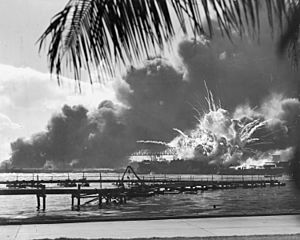
Command Structure
After the attack on Pearl Harbor, Roosevelt chose Admiral Ernest J. King (1878–1956). King was experienced in big guns, aviation, and submarines. He was dedicated to victory. He was a very powerful admiral. He made all decisions from Washington and kept them secret. The civilian Secretary of the Navy had little power until James Forrestal took over in 1944. Despite the Joint Chiefs of Staff wanting to focus on Germany first, King made defeating Japan his top priority. For example, King insisted on fighting for Guadalcanal despite Army objections. His main attack force was built around carriers at Pearl Harbor, led by Chester Nimitz. Nimitz had one main battle fleet, with two command systems that rotated between Admiral Bull Halsey and Admiral Raymond A. Spruance.
The Navy had a big advantage: it had broken the Japanese code. It figured out that Hawaii was the target in June 1942. It also knew that Yamamoto's fleet would attack Midway Island. King had only four carriers. He sent them all to Midway. In a few amazing minutes, they sank the Japanese carriers. This gave the Americans a firepower advantage that grew quickly. New American warships were built much faster than Japan could build them. King paid special attention to submarines. They were used against Japan's stretched-out supply system. They were built for long missions in warm waters. Their goal was to sink the freighters, troop transports, and oil tankers that kept Japan's empire together. The South West Pacific Area, based in Australia, was led by Army General Douglas MacArthur. King gave him his own fleet, led by Admiral Thomas C. Kinkaid, without big carriers.
Carrier Warfare
On December 7, 1941, Japan's carriers launched the Attack on Pearl Harbor. They sank or disabled the entire battleship fleet. This huge defeat forced Admiral King to create a new strategy based on carriers. Even though the sunken battleships were raised and many new ones built, battleships played a secondary role in the war. They were mainly used to bombard islands before amphibious landings. The "Big Gun" club, which had controlled the Navy since the Civil War, lost its power.
The US was helpless for the next six months as the Japanese swept through the Western Pacific and into the Indian Ocean. They took the Philippines and the main British base at Singapore. After these defeats, the Navy stabilized its lines in summer 1942.
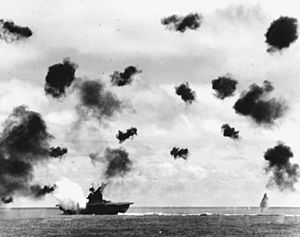
At the start of the war, the US and Japan had similar numbers and quality of aircraft carriers. But the Mitsubishi A6M Zero fighter plane was better than the American F4F Wildcat in range and maneuverability. By studying a captured Zero, American engineers found its weaknesses. These included poor protection for the pilot and fuel tanks. They built the Hellcat as a better weapon. In late 1943, the Grumman F6F Hellcats entered combat. They were faster (400 mph) than Zeros, climbed quicker (3,000 feet per minute), were better at high altitudes, and had more armor and firepower. Although heavier and with shorter range, the Hellcat was a much better weapon overall. Japan's carrier and pilot losses at Midway crippled its ability to attack. America's strong attack power came from shipyards that built ships much faster than Japan. It also came from refineries that made high-octane gasoline and training fields that produced much better pilots. In 1942, Japan commissioned 6 new carriers but lost 6. In 1943, it commissioned 3 and lost 1. The turning point was 1944, when it added 8 and lost 13. By war's end, Japan had 5 carriers stuck in port. All were damaged, lacked fuel, and had no warplanes. Meanwhile, the US launched 13 small carriers in 1942 and one large one. In 1943, it added 15 large and 50 escort carriers. More arrived in 1944 and 1945. The new American carriers were much better designed, with more anti-aircraft guns and powerful radar.
Both sides were stretched thin in the battles for Guadalcanal. The Japanese were better at night combat. However, the Japanese couldn't feed their soldiers. So, the Americans eventually won due to better supplies. The Navy built up its forces in 1942–43. It developed an "island-hopping" strategy. This meant skipping heavily defended Japanese islands and taking other islands for air bases.
In the Atlantic, the Allies fought a long battle with German submarines. This was called the Battle of the Atlantic. Navy aircraft flew from bases in Greenland and Iceland to hunt submarines. Hundreds of escort carriers and destroyer escorts were built to protect merchant convoys. In the Pacific, US submarines fought Japanese shipping. By January 1945, submarines had effectively destroyed the Japanese merchant fleet. This cut off Japan's oil supply. By the end of the war, the US had 260 submarines. It lost 52 submarines during the war, 36 in the Pacific.
In summer 1943, the US began the Gilbert and Marshall Islands campaign. After this success, Americans went to the Mariana and Palau Islands in summer 1944. After their defeat at the Battle of Saipan, the Imperial Japanese Navy's fleet attacked the Navy's Fifth Fleet during the Battle of the Philippine Sea. This was the largest aircraft carrier battle in history. The battle was so one-sided it was called the "Marianas turkey shoot." The US lost 130 aircraft and no ships. The Japanese lost 411 planes and 3 carriers. After winning in the Marianas, the US began to retake the Philippines at Leyte in October 1944. The Japanese fleet attacked the invasion fleet. This led to the four-day Battle of Leyte Gulf, one of the largest naval battles ever. The first kamikaze missions were flown during this battle. They sank USS St. Lo and damaged other US ships. These attacks were the most effective anti-ship weapon of the war.
The Battle of Okinawa was the last major battle between US and Japanese ground units. Okinawa was to be a staging area for the invasion of Japan. Marines and soldiers landed on April 1, 1945. This began an 82-day campaign. It was the largest land-sea-air battle in history. Japanese kamikaze pilots caused the largest loss of ships in US naval history. They sank 36 ships and damaged 243 others. Total US casualties were over 12,500 dead and 38,000 wounded. The Japanese lost over 110,000 men. This made Okinawa one of the bloodiest battles in history.
The fierce fighting on Okinawa may have influenced President Truman's decision to use the atomic bomb. This avoided a full invasion of Japan. When the Japanese surrendered, 374 ships entered Tokyo Bay. The ceremony happened on the battleship USS Missouri. By the end of the war, the US Navy had over 1200 warships. It was larger than the Royal Navy.
The Cold War (1945–1991)
After World War II, many Navy ships were scrapped or put into storage. By 1948, only 267 ships were active. In 1948, the Women's Armed Services Integration Act gave women permanent status in the Navy.
Revolt of the Admirals
The military services were combined in 1947, despite strong objections from Navy Secretary James Forrestal. President Truman made him Secretary of Defense. But they disagreed over budgets. Truman fired him in 1949 when Forrestal sided with the Navy in a public protest. This was known as the Revolt of the Admirals. The Navy wanted expensive aircraft carriers. Truman fired Forrestal and canceled the carrier. He also planned to move Marine Corps aviation to the Air Force. Public opinion turned against the Navy during Congressional hearings. In the end, the Navy kept Marine aviation and eventually got its carrier. But its protesting admirals were punished. Civilian control over the military was confirmed. Military budgets after the hearings focused on Air Force heavy bombers.
The Navy slowly became known for having the most advanced technology. The 1950s saw the development of nuclear power for ships. Admiral Hyman G. Rickover led this. Missiles and jet aircraft were developed for Navy use. Supercarriers were built. USS Enterprise was the world's first nuclear-powered aircraft carrier. It was followed by the Nimitz-class supercarriers. Ballistic missile submarines became more deadly and quiet, like the Ohio-class submarines. Rickover had strong support in Congress. He made nuclear power a high Navy priority, especially for submarines. With missile technology, this gave the US the ability to strike back if attacked. This was key to stopping the Soviet Union.
Tensions with the Soviet Union and China peaked in the Korean War. It became clear that the peacetime Navy needed to be much larger. Fleets were assigned to areas worldwide. Ships were sent to hot spots as a standard response to crises. The Korean War had few naval battles because the North Korean navy was small. Navies mostly supported armies on land. A large amphibious landing at Inchon pushed the North Koreans back. The Battle of Chosin Reservoir ended with the evacuation of almost 105,000 UN troops.
The US Navy's 1956 shipbuilding program was important. It included building eight submarines, the largest order since World War II. This included five nuclear-powered submarines and the last three diesel-electric submarines.
Vietnam War
A mix of Navy ships fought in the Vietnam War (1965–72). Aircraft carriers offshore launched thousands of air strikes. Small gunboats of the "brown-water navy" patrolled rivers. Despite naval activity, new ship construction was cut by Presidents Johnson and Nixon to save money. Many carriers on Yankee Station were from World War II. By 1978, the fleet had shrunk to 217 surface ships and 119 submarines.
Soviet Challenge
Meanwhile, the Soviet fleet grew. It outnumbered the US fleet in every type except carriers. The Navy thought it might be defeated by the Soviet Navy in a major conflict. This led the Reagan administration to aim for a 600-ship Navy. By 1988, the fleet had 588 ships. The Iowa-class battleships Iowa, New Jersey, Missouri, and Wisconsin were reactivated. They were modernized and made impressive appearances. In 1987 and 1988, the US Navy fought Iran in the Persian Gulf. This included Operation Praying Mantis, the largest surface-air naval battle since World War II.
After the Cold War (1991–Present)
After the Soviet Union collapsed, its Navy fell apart. It didn't have enough people or money to maintain its ships. Many were sold to other countries. This left the United States as the world's strongest naval power. US naval forces did shrink in size. But compared to other nations, the US still has huge naval power. This is shown by its 11 aircraft supercarriers and their support groups. In the 1990s, US naval strategy focused on being able to fight two smaller wars at the same time in different places.
Navy ships took part in several conflicts after the Cold War. In the 1991 Gulf War with Iraq, the Navy was key. Its ships launched hundreds of Tomahawk II cruise missiles. Naval aircraft flew missions from six carriers. The battleships Missouri and Wisconsin fired their 16-inch guns for the first time since the Korean War. In 1999, Navy and Marine Corps aircraft flew thousands of missions against targets in Serbia and Kosovo. This was to stop ethnic cleansing in Kosovo. After 78 days, Serbia gave in to NATO's demands.
In 2012, the Chief of Naval Operations (CNO) ordered a new way to choose command officers. This was because many command officers had been fired for not doing their job well.
In March 2007, the US Navy reached its smallest fleet size since World War I, with 274 ships. Since the Cold War, the Navy has focused less on large-scale war. Instead, it focuses on special operations and strike missions in regional conflicts. The Navy took part in the Iraq War and is a major part of the ongoing War on Terror. New ships and weapons are still being developed. These include the Gerald R. Ford-class aircraft carrier and the Littoral combat ship. One hundred three US Navy personnel died in the Iraq War. US Navy warships launched cruise missiles into military targets in Libya during Operation Odyssey Dawn. This was to enforce a UN resolution.
Former US Navy admirals have worried about the Navy's ability to respond to "aggressive moves by Iran and China." The Navy is shifting its focus to the Pacific. Defense Secretary Leon E. Panetta said the Navy would change from a 50/50 split between the Pacific and Atlantic to a 60/40 split favoring the Pacific. This doesn't mean a huge increase of troops or ships. But some of the most advanced ships will focus on the Pacific.
On January 12, 2016, Iranian forces captured ten Navy personnel. Their two boats entered Iranian waters. They were released the next day after talks.
In mid-2017, two Navy ships, USS Fitzgerald and USS John S. McCain, were involved in collisions with merchant ships. These accidents resulted in deaths.
In 2020, the Chinese Navy became larger than the United States Navy in terms of ship numbers. The United States had been the largest navy since it passed the Royal Navy in 1943.


